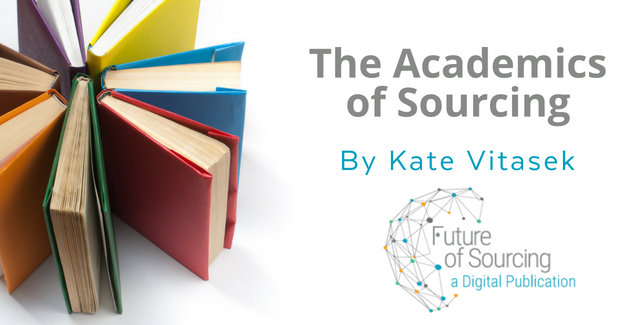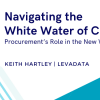In anticipation of the return of Kate Vitasek’s column “The Academics of Sourcing,” Outsource is pleased to showcase some of her best articles from the archives.
“The Academics of Sourcing” is a series that regularly shares some of the best academic insights and translates the learnings from academia into sound advice for practitioners.
Read on to get reacquainted with Kate Vitasek’s insight and experience into the world of sourcing and the academics behind it.
This week’s column focuses on big thinker Ronald Coase. Coase, a giant of modern economic science and 1991 Nobel laureate helps us understand a key fundamental of business: that business (and outsourcing decisions) are a math problem.
While outsourcing has been in the limelight for some 20 years, various threads of economic thought and research stretching for more than 80 years planted the seeds of modern outsourcing, centering on growth theory, transaction costs, game theory, property rights, deregulation and the nature of the firm.
That’s good, but economics is often called the dismal science, a term coined by the Scottish writer, essayist and historian Thomas Carlyle to describe the discipline. Perhaps that is because as a discipline it is so undisciplined, inexact and uncertain.
Then there’s Adam Smith’s “invisible hand” of economics, a term used by economists and academics to describe the self-regulating nature of the marketplace.
Attempting to reconcile all that, it’s easy to see how economic theory can get a bit dismally and invisibly confusing. Much of the academic thought and research in the 20th century sought to bring some order and structure to economics, to make it, if you will, less dismal and more visible.
That’s when Coase enters the picture and where economics begins to make some sense, or at least add up. Coase, born in 1910, is a British-born American economist and the Clifton R. Musser Professor Emeritus of Economics at the University of Chicago Law School. Having lived to be 102 years old, his wisdom has proved to have the longevity of his life.
Coase shed much-needed light on a concept known as transaction costs. He said it is not enough to include only production and transportation costs as the main expenses of doing business – the traditional way of thinking about business costs. He advocated companies also needed, for example, to consider the cost of entering into and executing contracts.
Boiled down in the simplest terms: business is a math problem and companies need to understand not just the price – but the total cost, including the nebulous “transaction” costs of simply doing business.
This seems fairly obvious today but Coase’s inclusion of contracting and contracting costs into the mix of a firm’s organizational structure and accounting was new stuff in the 1930s. In many ways, his work helped lay the foundation for outsourcing and outsource contracting to become a normal and major part of a firm’s strategy. Sometimes it was simply cheaper to buy than to make when you ran the numbers.
Coase is best known for two articles.
The first, “The Nature of the Firm” (1937), introduced the term "transaction costs" to explain the nature and limits of firms. The second, “The Problem of Social Cost” (1960), described the economic efficiency of an economic outcome that can produce costs or benefits in the presence of factors unrelated to price. Later named the Coase theorem by George Stigler, Coase suggested that well-defined property rights could overcome the problems of those so-called “externalities.” Today, the Coase theorem is an important and much-debated basis for most modern economic analyses of government regulation.
Coase’s breakthroughs showed that traditional microeconomic theory was incomplete because it only included production and transportation costs while neglecting the costs of entering into and executing contracts and managing organizations. Those costs are now commonly known as transaction costs, and they account for a major share of the total use of resources in the economy.
“Traditional theory had not embodied all of the restrictions which bind the allocations of economic agents,” the Royal Swedish Academy explained when they awarded Coase the Nobel Prize in 1991. “When transaction costs are taken into account, it turns out that the existence of firms, different corporate forms, variations in contract arrangements, the structure of the financial system and even fundamental features of the legal system can be given relatively simple explanations. By incorporating different types of transaction costs, Coase paved the way for a systematic analysis of institutions in the economic system and their significance.”
Coase showed that the distribution of property rights among individuals tends to be reallocated through contracts if it is to the mutual advantage of the parties and not prevented by transaction costs, and that institutional arrangements other than contracts emerge if they imply lower transaction costs.
Coase’s work has led to the intense examination of the contract relations that characterize firms, including the specific distribution of their rights and obligations. It became the basis for rapidly expanding research on principal-agent relations and also “influenced vital aspects of financial economics, such as the lively research devoted to explaining the pattern of financial intermediaries.”
He concluded that the institutional structure of the economy is explainable by the relative costs of different institutional arrangements, combined with parties’ efforts to keep total costs to a minimum. Alongside price formation, the formation of the institutional structure is regarded as an integral step in the process of resource distribution and industrial organization.
In his Nobel Prize lecture, Coase said: “I argued in ‘The Nature of the Firm’ that the existence of transaction costs leads to the emergence of the firm. But the effects are pervasive in the economy. Businessmen in deciding on their ways of doing business and on what to produce have to take into account transaction costs. If the costs of making an exchange are greater than the gains which that exchange would bring, that exchange would not take place and the greater production that would flow from specialization would not be realized. In this way, transaction costs affect not only contractual arrangements but also what goods and services are produced.”
Ignoring transaction costs “leaves many aspects of the working of the economic system unexplained,” Coase said, including the emergence of the firm, but much else besides. “In fact, a large part of what we think of as economic activity is designed to accomplish what high transaction costs would otherwise prevent or to reduce transaction costs so that individuals can freely negotiate.”
Thanks to Coase, the lesson for today’s outsourcing firms is that when outsourcing, think about the total cost – not just the price and/or budget of the work that is outsourced. If you make your decisions solely on the price of the work scope and not the total costs you will have a myopic and highly inaccurate view of the outsourcing deal.






